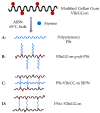Stronger Together. Poly(Styrene) Gels Reinforced by Soft Gellan Gum
- PMID: 36286108
- PMCID: PMC9601398
- DOI: 10.3390/gels8100607
Stronger Together. Poly(Styrene) Gels Reinforced by Soft Gellan Gum
Abstract
This study targets the synthesis of novel semi-interpenetrating networks and amphiphilic conetworks, where hydrophilic soft matter (Gellan Gum, GG) was combined with hydrophobic rigid poly(styrene), PSt. To achieve that, GG was chemically modified with 4-vinyl benzyl chloride to form a reactive macromonomer with multiple double bonds. These double bonds were used in a copolymerization with styrene to initially form semi-interpenetrating networks (SIPNs) where linear PSt was intertwined within the GG-PSt conetwork. The interpenetrating linear PSt and unreacted styrene were extracted over 3 consecutive days with yields 18-24%. After the extraction, the resulting conetworks (yields 76-82%) were able to swell both in organic and aqueous media. Thermo-mechanical tests (thermal gravimetric analysis, differential scanning calorimetry, and dynamic mechanical analysis) and rheology indicated that both SIPNs and conteworks had, in most cases, improved thermal and mechanical properties compared to pure poly(styrene) and pure GG gels. This crosslinking strategy proved that the reactive combination of a synthetic polymer and a bio-derived constituent would result in the formation of more sustainable materials with improved thermo-mechanical properties. The binding ability of the amphiphilic conetworks towards several organic dyes was high, showing that they could be used as potential materials in environmental clean-up.
Keywords: Gellan Gum; amphiphilic; conetworks; gels; semi-interpenetrating networks.
Conflict of interest statement
The authors declare no conflict of interest.
Figures
















References
-
- Ku P.L. Polystyrene and styrene copolymers. I. Their manufacture and application. Adv. Polym. Technol. 1988;8:177–196. doi: 10.1002/adv.1988.060080204. - DOI
-
- Wypych G. Handbook of Polymers. ChemTec Publishing; Scarborough, ON, USA: 2012. PS polystyrene; pp. 541–547. - DOI
-
- Hetzer M., De Kee D. Wood/polymer/nanoclay composites, environmentally friendly sustainable technology: A review. Chem. Eng. Res. Des. 2008;86:1083–1093. doi: 10.1016/j.cherd.2008.05.003. - DOI
Grants and funding
LinkOut - more resources
Full Text Sources

